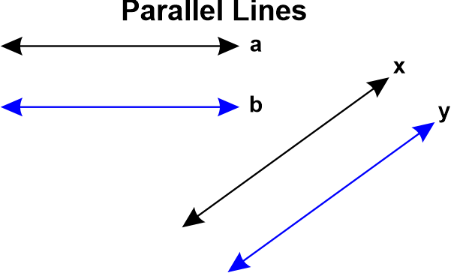Parallel Lines DefinitionParallel lines are lines in a plane that remain equidistant and do not intersect. In other words, they run side by side without ever touching or crossing each other. This concept is fundamental to geometry and has a wide range of applications in fields such as architecture, engineering, and computer graphics. 
Ways to define parallel linesParallel lines can be defined using several different mathematical tools and techniques. One of the most common ways to define parallel lines is to use the concept of slopes. The slope of a line is the ratio of the vertical change of the line to its horizontal change. Parallel lines have the same slope, meaning that they rise and fall at the same rate. Another way to define parallel lines is to use the concept of angle. In geometry, two lines that are parallel to each other have the same angle between them, regardless of their direction. This is known as the transversal line, and it intersects the two parallel lines at different points. Properties or parallel lines
This property is important in fields such as engineering, where parallel lines are used to design structures such as bridges and buildings. Application of parallel linesParallel lines also play an important role in the study of trigonometry. In trigonometry, parallel lines are used to calculate angles and distances between objects. For example, the angles of elevation and depression can be used to calculate the height of an object, such as a building or a mountain, based on its distance from a observer. In computer graphics, parallel lines are used to create images that appear three-dimensional. This is done by using a technique known as perspective projection, where parallel lines are drawn in such a way that they converge to a single point, creating the illusion of depth. This technique is widely used in video games, animated films, and other forms of digital media. Parallel lines also play a role in the study of linear algebra. In linear algebra, parallel lines are used to describe relationships between vectors and to solve systems of linear equations. This includes finding the solution to problems such as finding the intersection of two lines, which is important in fields such as computer graphics and engineering. Parallel lines have several important applications in the real world. For example, in cartography and surveying, parallel lines are used to create maps and measure distances on the Earth's surface. Surveyors use instruments such as theodolites and transits to determine the angle and distance between parallel lines on the ground, allowing them to accurately measure and map large areas of land. From cartography and surveying to architecture and engineering, parallel lines are used to create structures, measure distances, and solve a variety of problems. Whether you're a mathematician, an engineer, or a computer scientist, understanding parallel lines is essential for success in your field. In architecture and construction, parallel lines are used to design and build structures that are both aesthetically pleasing and functional. Architects use parallel lines to create plans and elevations for buildings, ensuring that the structure is stable and meets all building codes and regulations. Parallel lines also play an important role in the field of engineering. Engineers use parallel lines to design and construct a wide range of structures, from bridges and roads to aircraft and spacecraft. For example, engineers use parallel lines to determine the strength and stability of bridges, ensuring that the structure can support the weight of cars and trucks passing over it. In addition, parallel lines are also used in the field of optics and light transmission. Parallel light beams are used in fiber optic communication systems to transmit signals over long distances without the signal becoming distorted. This allows data and information to be transmitted quickly and efficiently over long distances, making it possible to connect people and businesses all over the world. In computer vision, parallel lines are used to determine the orientation and position of objects in a scene, allowing the computer to recognize and track objects in real-time. ConclusionIn conclusion, parallel lines are a fundamental concept in geometry and have a wide range of applications in fields such as architecture, engineering, computer graphics, trigonometry, and linear algebra. Parallel lines are defined as lines that remain equidistant and do not intersect, and can be defined using several different mathematical tools and techniques, such as slopes and angles. Understanding parallel lines is important for solving a variety of real-world problems and for creating images and structures that appear three-dimensional.
Next TopicPharmacokinetics Definition
|
 For Videos Join Our Youtube Channel: Join Now
For Videos Join Our Youtube Channel: Join Now
Feedback
- Send your Feedback to [email protected]
Help Others, Please Share









